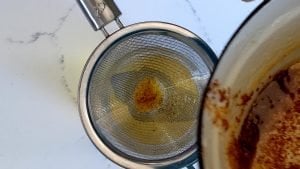Ghee is such an important oil in Indian culture, that it isn’t just a major part of cuisine, but also religious ceremonies. Ghee is used constantly in everyday cooking, and as a condiment much the way butter is. It isn’t the only oil used in Indian cooking, but it is the most beloved oil, and has always been the main fat used in my home.
Homemade ghee is vastly superior to store-bought. I don’t know if manufacturers use inferior butter or if it is the way it is stored, but store-bought ghee simply can’t compete with homemade ghee.
And that is good news, because ghee is very easy to make at home and costs about half as much (or less) as a jar from the store.
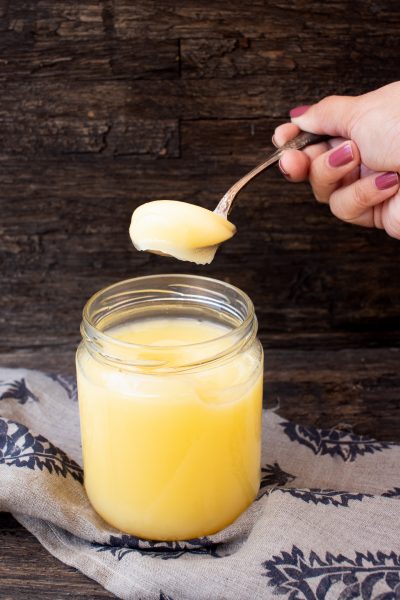
Is Ghee Clarified Butter?
Ghee is often described as clarified butter. But it is not exactly the same thing. Clarified butter is made by heating up butter, letting the milk solids separate from the butter and the water to evaporate.
Ghee is made the same way, except it is cooked for longer and the milk solids are allowed to caramelize in the oil before they are removed. This gives ghee it’s characteristic caramelization and nutty taste.
Ghee is like butter except:
- The smoke point is 465°F (240°C), higher than vegetable and peanut oils, the smoke point of butter is 302°F
- Ghee will not spoil or oxidize as easily as butter, meaning it can last a long time without becoming rancid
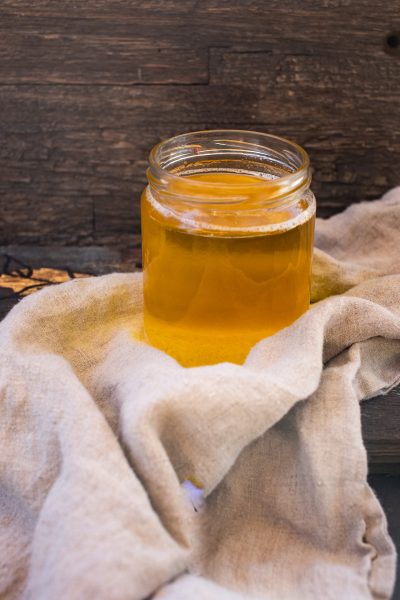
When to Cook with Ghee
The advantage of ghee over butter is that by removing the milk solids and water, we raise the smoke point of the oil. That makes ghee suitable as a frying oil. Indian sweets are fried in ghee, or sometimes a mixture of oil and ghee to get some of the ghee flavor.
I always include at least a tablespoon of ghee in my frying oil when I make ghughra and gulab jamun. I also use it when baking with Indian flavors, such as for Gulab Jamun Cake.
However, you would not use ghee to fry puris, kachori, or anything savory. Instead you would use a neutral oil.
I was also taught to not use ghee for a dry shaak. If a dry shaak gets cool, the ghee will solidify and create unpleasant mouthfuls of fat. That reasoning doesn’t make a lot of sense to me because you don’t eat food cold and ghee melts at a mere 85°, but it helps me remember to always use oil for these shaaks.
What to Eat with Ghee
Ghee isn’t just used for cooking. It is also an everyday condiment, much like butter. In fact, Indians consider ghee to be very healthy, even though it is almost pure fat.
It is especially eaten in the winter. My grandma grew up eating a chunk of solidified ghee every winter morning as protection against the bitter cold of Gujarat’s. Every morning, she and her 9 siblings would line up and their mother would give them a chunk of ghee to eat, spooned straight out of the jar.
One of the things I grew up eating that I love is stuffing a date with ghee and refrigerating it so the ghee is solid and cold. Rotis are brushed with ghee. Ghee is added to the rice water when making basmati rice, before it is boiled, to prevent the water from boiling over. Additionally, I always add a dollop of ghee to rice as it is served.
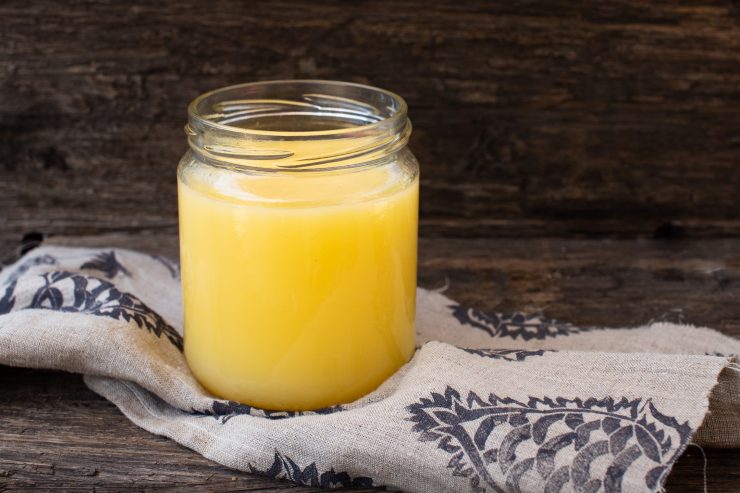
Ghee and Hinduism
Ghee is very much a part of Hindu culture. Cow and cow products are considered holy in Hinduism. So, naturally, ghee is used in religious cermony.
When my mom does her daily puja, there is always a little lamp with a spoonful of ghee.
Ghee is also used in hovens. You pour ghee into an open fire. A hoven is an open fire used in a religious ceremony. For example, I had one at my wedding. My parents also do a daily hoven for navratri.
What Type of Butter to Make Ghee With?
An important question about making ghee is whether it makes sense to use a fancy butter. My mom and many Indians I know use Kerrygold butter to make their ghee.
Ghee is very important in Indian cuisine. The best food comes from the best ingredients. So it follows that you would want to use good butter for good ghee.
However, most of the taste from ghee doesn’t come from the butter, but from the caramelization of the milk solids. If your budget allows for it, use the farm-fresh, pasture raised artisanal butter, but don’t expect it to taste a whole lot different than the ghee made from the 4 pack of butter from Costco.
The other question is whether to use salted butter or unsalted butter. Technically you should use unsalted butter. But even salted butter doesn’t have a lot of salt in it. If all you have on hand is salted butter, it will work just fine.
That said, traditional ghee, which is less commonly used today, is made from cultured butter, which is made from yogurt. It has a slightly sour, funky flavor. In a separate post I explain the whole process of making yogurt, makhan (butter), and traditional ghee from whipping cream.
My mom often uses salted butter and it never causes problems even when using it to fry sweets.
Tips for Making Ghee
- Cooking too hot or for too long and burning the milk solids will create a bitter taste
- Make sure to use a heavy bottomed pan or hot spots in the pan will also cause milk solids to burn
- Make sure to cook it long enough – you have to make sure to get all of the water out and allow the milk solid to brown somewhat to impart the “ghee” flavor.
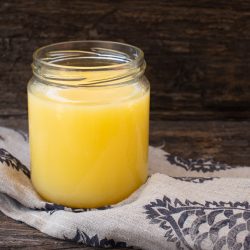
Ghee
Ingredients
- 2 cups butter
Instructions
- Melt 2 cups (4 sticks) of butter in a heavy-bottomed pot. You can use more or less butter depending on how much ghee you want to make. Stir to prevent burning.

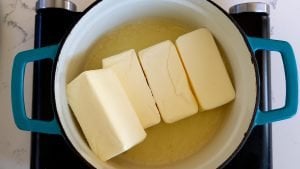
- When the butter has melted, lower the heat to just the point of a steady rolling boil. Simmer until the milk solids have dropped to the bottom and are a nutty brown color. The water should also be completely boiled off. It should take about 20-30 minutes.

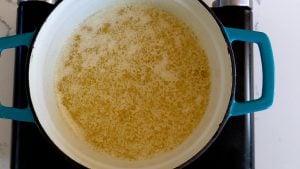
- Allow to cool and settle for at least a few minutes. Pour into a jar, leaving the milk solids behind. It is easiest to do this by catching any milk solids with a sieve.

